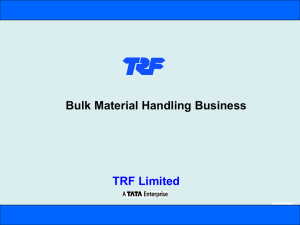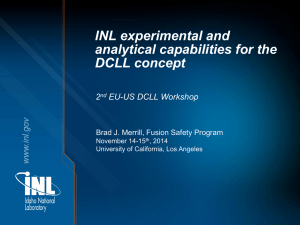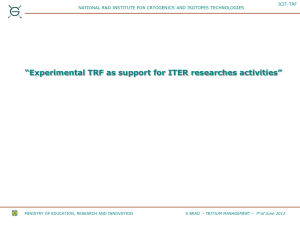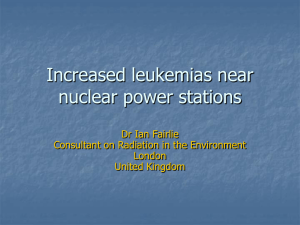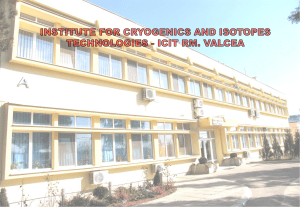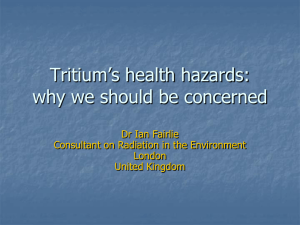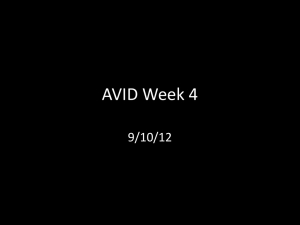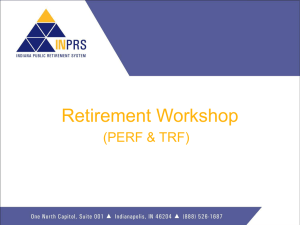ICSI – TRF
advertisement
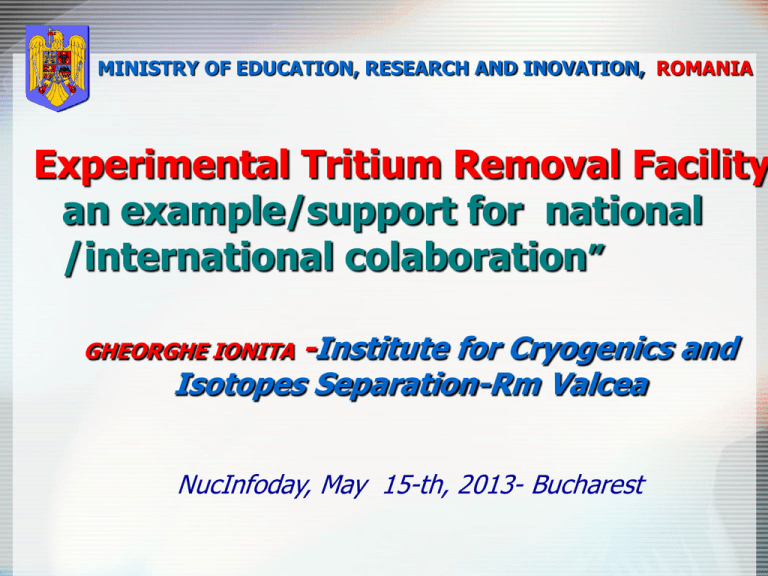
MINISTRY OF EDUCATION, RESEARCH AND INOVATION, ROMANIA Experimental Tritium Removal Facility an example/support for national /international colaboration” -Institute for Cryogenics and Isotopes Separation-Rm Valcea GHEORGHE IONITA NucInfoday, May 15-th, 2013- Bucharest Cernavoda Nuclear Power Plant LIQUID EFFLUENTS EMISSIONS (1996-2009) Tritium Liquid Emissions CNE Cernavoda - Unit 1 3.25E+11 2.45E+11 2.60E+11 kBq 1.95E+11 1.95E+11 1.54E+11 1.54E+11 1.14E+11 1.30E+11 6.50E+10 1.14E+11 8.47E+10 5.21E+10 4.35E+10 1.93E+10 6.18E+10 1.16E+10 7.88E+08 7.56E+10 0.00E+00 1996 1997 1998 1999 2000 2001 2002 2003 2004 2005 2006 2007 2008 2009 TRITIUM LIQUID EMISSIONS FOR UNIT 2(2007-2009) Tritium Liquid Emissions Unit 2 2007 - 2009 5.44E+09 4.68E+09 4.76E+09 4.08E+09 kBq 3.40E+09 2.72E+09 1.83E+09 2.04E+09 1.36E+09 6.80E+08 5.27E+08 0.00E+00 2007 2008 ye ar 2009 Tritium concentration in precipitation(arithmetic and weighted mean) at ICSI Rm-Valcea(1999-2009) Premises • Permanent increase of the tritium level in heavy water ( steady state-65-80Ci/l) from CERNAVODA NPP, due to neutron activation; •Operation dificulties in safety conditions; •High cost for replace and storage tritiated heavy water; • Environment contamination risk; • Neccessity to protect the operational staff of NPP; • Tritium it’s a valuable material of real interest for ITER and other applications; • An effective and efficient technology for heavy water detritiation and afferent Tritium Removal Facility it’s requested Heavy Water Detritiation Technologies Company Technology Current Status ILL Grenoble, Franta VPCE+CD Decommissioned Ontario Hydro, Darlington, Canada AECL, Canada In operation >20 years CECE + CD FZK, Germania ICSI, Romania Demonstration (shut down) In operationlaboratory experiments) LPCE + CD Wolsung, Korea Pre-operational In Operation Fugen, Japonia LPCE Decommissioned Candu Owner Group DE + CD Conceptual Project HEAVY WATER DETRITIATION TECHNOLOGY ( Liquid Phase Catalytic Exchange Cryogenic Distillation- LPCE – CD ) A) tritium transfer from water - by isotopic catalytic exchange B) tritium concentration - by cryogenic distillation C) tritium safe storage - (as metallic hidride) Experimental Pilot Plant for Deuterium and Tritium Separation Start of the Project – 1992 – the first stage as semiindustrial scale plant for hydrogen isotope separation; Finalisation of the Project – 1997 – commissioning with hydrogen, deuterium isotopes; In the year 2000, after reaching the normal operation and proved the technology it begun the next stage – implementig of the necessarry request to modify into nuclear facility; In 2004-2010 – cold experiments by deuterium simulation and implementing the modifications to be licensed by Romanian Regulatory Body CNCAN (National Commission for Nuclear Activities Control); In 2009 we got the first barrel with 200 kg of 3,31e-8 Bq/kg tritiated water ( excepted limit for regulations by CNCAN) Initial Design Targets • tritium maximum activity in heavy water: 30 Ci/kg • maximum tritium inventory: 300,000 Ci • quantity of heavy water annually processed : 2000 kg • minimum deuterium concentration in feed water: 99.8 % • water feed rate: 8 kg/h • tritium inventory in CD: 200,000 Ci • design service life: 30 years ICIT – Tritium Removal Facility ICSI – TRF’ Curent Status • Shut-down for up-grading and lincensing as nuclear facility • Technical project: – – – – – CD system increasing refrigeration power (class 3 and 6 equipment) LPCE column replaced with new catalyst/package design (class 3 equipment) Purification system redesign Tritium storage redesign (use uranium and titanium getter beds) Utilities modification based on new requirements Elaboration of decommissioning plan of TRF • Detailed design: – Overall revision – – – – Licensing requirements review (hazard category 3) Design requirements review Safety systems list review FSAR review based on new project (new safety analysis required) • Licensing: Upgrading – Cryogenic Distillation • The upgrading-extending process comprise technological design, equipment acquisition and installation • Equipment proposed to be procured: Helium refrigeration unit – 1000 W at 20 K – compressor, helium tank, helium cold-box, helium transfer line; Tritium storage system; Cold-box for the cryogenic distillation module; Experimental cascade system for the cryogenic distillation; Control and measurement system for the cryogenic distillation module; CATALYSTS • Preparation, characterization and testing of catalysts for: 1- hydrogen- water isotopic exchange in liquid phase( LPCE); 2- hydrogen-oxygen recombination ( stoechiometric mixtures); 3- removal of volatile organic compounds(formaldehyde, BTX; alchools;etc) from water; 4- catalysts for fuell cell 5 - conversion of greenhouse gases in friendly environmental compounds; 6 - recycling of solid waste; 7 - conversion of biomass in products with energetic value; • Charactherization: metal content; surface area; size particle; metal area; total volume and pore distribution ;mechanical strength; • Hydrophobic catalaysts for 1-4 applications (Pt/C/PTFE; Pt/SDB; Pt/C/PTFE-ZnO; Pt/C/PTFE-TiO2) – tablets and rings with metal content-0.4-2%; surface area 16-120 m2/g; metal area 120 m2/g; mechanical strength-1.7-6.6 k gf/pellet CATALYSTS Packings for water distillation Packings of 100 mm diameter PACKING OF 800MM DIAMETER Implementation of Detritiation Facility at Cernavoda NPP Cernavoda TRF Facilities(CTRF) • Project started in 2008. Technical project, detailed design and licensing • Subject: tritium removal facility for U1/U2 • CTRF scope: – Detritiation of heavy water moderator produced by operation of U1 – Operating of CTRF on line for U1&U2 – Decommissioning support for U1&U2 • Future TRF – U3&U4 CTRF Technical Specification (initial) • CTRF will start at 54 Ci/kg (estimated) • To reduce the tritium content to 10 Ci/kg in 2 years (heavy water moderator) • Feed: 40 Kg/h • Detritiation factor 100 • Upgrading possibility for heavy water - from minimum 99.7% to 99.95% • To be used by U1 and U2 • Design for 40 years lifetime • Long term storage space for tritium Cernavoda CTRF-2 Considerations - Lifetime of TRF – 40 years • Actual planned CTRF design can not support U3&U4: – U3&U4 – private investment, but CNE Cernavoda has operating responsibilities – detritiation for U3&U4 start operating; 20 years later than U1; – Location of CTRF – no pipe route for heavy water transport and high distance – Operating of CTRF also for U3&U4 can affect the target for U1/U2 (no capacity available) Conclusion – U3&U4 need new TRF Schedule for ICSI & CNE TRF ICSI TRF CNE TRF Year 2011 Design (technical project) Design (detailed design) Procurement Construction Licensing Commissioning Operating 2012 2013 2014 2015 2016 2017 2018 • COMPARISON BETWEEN ICIT-TRF AND CERNAVODA -CTRF Main data comparison ICSI TRF CERNAVODA TRF Flow (kg/h) 7 40 Detritiation factor 3 100 Front-end LPCE (1 column, Ø100x6 m) LPCE (3 columns, Ø400x17m each) Back-end CD (hydrogen, 140W*) CD (helium, 12000W) 6 g tritium, no vault 5 kg tritium, secured vault OPEX ICSI, ITER (experimental facilities) ICSI, ITER (experimental facilities) WTRF, DTRF (industrial) Status Commissioning (stopped*) Design phase Storage capacity * Project change to 1000W (2010-2012) Design comparison ICSI TRF Main systems (LPCE, CD) Cernavoda TRF Same technology ADS 100 mc/h 2000 mc/h TRS No Yes LCS Feed & product purification Same No Feed the plant by barrel Yes, specific equipment. Feed by pipes DMS Yes (equipment to be installed) Yes HVAC 2 exchanges/h 10 exchanges/h, hydrogen ventilation 1 x 100 KVA 2 x 250 KVA Class III Diesel Generator Lessons learn for CTRF-2 • Location – in U3/U4 project TRF location should be included • Safety analysis for U3/U4 should take in consideration TRF events • Utilities – based on actual CTRF project, utilities requirements for TRF should be included • Operating – CTRF-2 design systems should be changed: building with more space and different layout, all systems inside CTRF-2 building (ex. HWFS, HWPS), underground pipes for heavy water transfer • Applicable code and standards CTRF-2 discussions • Companies involved in U3&U4 project are aware about TRF • Discussions related to new TRF started as initial investigation • Energonuclear and AMEC investigate TRF approach. TRF construction for U3&U4 will be recommended. CONSORTIUM WORK RELATED TO ITER LINK TO ITER-EURATOM PROGRAM(I) ITER - WDS For ITER, the WDS is one of the key systems to control the tritium content in the effluent streams, to recover as much tritium as possible and consequently to minimize the impact to the environment. The most suitable process for water detritiation is the CECE process, a combination of electrolysis and catalytic exchange of hydrogen isotopes in a Liquid Phase Catalytic Exchange (LPCE) column. The separation duty of the CECE process for fusion reactors is very high (tritium concentration in the released H2 from the WDS for ITER shall be < 700 Bqm-3 air at a typical activity of tritium in the feed water of 370 GBqm-3). ITER - ISS The Isotope Separation System (ISS) envisaged to be used in ITER consists of a cascade of four cryogenic distillation columns with the aim to process a gas stream from the Vacuum Vessel via the Tokamak Exhaust Processing (TEP) system and a second one from the Water Detritiation System mixed with the return stream from the Neutral Beam Injectors. The ISS has to supply five streams with various tritium, deuterium and hydrogen composition. The top product of a CD column from ITER-ISS (CD1 column) has to be almost tritium free to be discharged into the environment, which is one of the main concerns from the licensing point of view Final remarks Experimental Pilot for Deuterium and Tritium Separation (TRF) it’s a national interest facility with the aim: - to check by simulation and in real conditions, the heavy water detritiation technology; - to suport research activities concerning the certain processes and behavior of materials at cryogenic temperatures/conditions; - to suport research activities linked to WDS and ISS facility within ITER – Fusion Project; • Based on experimental results obtained in real conditions, ICIT-TRF will offers significant results for designining and implementing an Industrial CTRF at U1 and U2 from Cernavoda NPP and will contribute to decreasing the tritium releases in the environment; • • • Based on lessons learn, ICIT make recommendation for future TRF implementation to U3&U4; TRF and future CTRF is mainly a result of national cooperation More international cooperation / exchange experience and technical assistance it’s still neccessary Main support from IAEA • Review of the curent status and future activities concerning operating of TRF and its implementation at CernavodaNPP-workshops2; expert mission-1; SV-3; • Equipment Procurement • Training of Human Resources: – Developing of methods for determination of tritium (stored and mobile) and deuterium inventory related to TRF;-fellowship – HAZOP Study for TRF operation- EM 1; SV-2 – Elaboration of Decommissioning Plan for TRF and U1-U2 reactor including CTRF and Radioactive Waste Management;- Training course ROM 02/009’ PLANNED ACTIVITIES in 2012 • 1. Experience Exchange- Scientific Visit at Wolsong TRF and KAERI( Koreea) for 3 researchers • Proposed data- April 2012; • Budget 3x 4333 = 12 999 Euro • Aditional request- extension the delegation at 6 ( researchers and engineers): – For 3 persons the fees will be covered within Project; – For 3 persons the fees will be covered by ICIT Rm-Valcea; – Apropriate agreement with Wolshong TRF it will neccessary in advance ROM 02/009’ PLANNED ACTIVITIES • 2. Acquisition/procurement of: • Gas tritium standards - for the calibration of the tritium process monitors and tritium in air monitors within TRF; – Charactheristics in Anexe 1; – Potential Supplier: Overhoff Technology Corporation ; • Specific Software (ISOGRAPH Package products) for complete risk analysis and hazard analysis; see Anexe 2 ISOGRAPH Package Software(anexe 2) • NSWC Module = (Mechanical) Failure Rates Prediction = 2,660.00Eu • Fault Tree+ Module = Fault and Event Tree diagram + Markov analysis =8,400.00Eu • RBD module = Reliability Block Diagram (Network) Analysis = 5,320.00Eu • FMECA module = Failure Mode, Effects and Criticality Analysis = 5,320.00Eu • MTTR module = Mean Time To Repair (Maintainability) = 1,260.00Eu • Allocation module = Method of apportioning a system target reliability amongst sub-systems and components = 1,260.00Eu • HAZOP module = Hazard and Operability Study = 2,520.00Eu • LOPA (Layers of Protection Analysis)-2,140 Eu • Risck analysis modules for electrical systems – 2,435 Eu • and the following libraries: • NPRD = Non-electronic parts = 672.00Eu • IAEA = library for mechanical component failure data = 560.00Eu • Total Estimated Price= 35 000 Eu ROM 02/009’ PLANNED ACTIVITIES in 2012 • 3. Training Course-( 1 person) on “Elaboration of deccomissioning plan of TRF and safety management of specific radioactive waste” ; • • • • Duration: 4-6 weeks Planned date- Q2- Q3 Budget- 10 000 Euro Aspects : Initial planned TC "Management of Radioactive Waste in Accordance with IAEA Safety Standards and International Best Practice" – organised by Clausthal University of Technology ( Germany) will take place in 2013; • Proposal: to find other similar course in 2012 or to replace it with workshop 1, planned in 2013 ( budget 15 000 Euro) PROIECTE EURATOM-EFDA • 1. Tehnologii de separare a izotopilor de hidrogen in sistemele de detritierea a apei grele (TWO-TRIT/REM) • 2. Optimizare raport umplutura/catalizator pentru transferul simultan al deuteriului si tritiului in sistemele de detritiere (JW0-FT-2.1) • 3. Test de anduranta a amestecului de umplutura/catalizator propus pentru sistemul de detritiere de la JET (JW – FT – 2.20) • 4. Permeatia tritiului in materiale (NUC – INT – UT 4) • 5. Proiectare a instalatiilor de procesare a tritiului pentru JET si ITER; (TW2-TI-TR39), (TW5-TTFD-TPI-51) zi (TW6-TTFD-TPI-55) • 6. Research Training Network - „Preparing the ITER Fuel Cycle“ • 7. JET Gamma-Ray Cameras Upgrade Neutron Attenuator (GRC_KN3_NA) • 8. Teste de anduranta ale componentelor sistemelor de detritiere a apei
